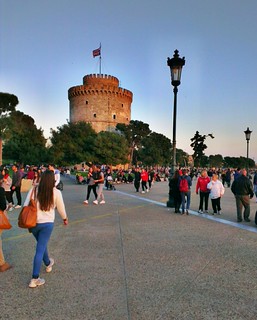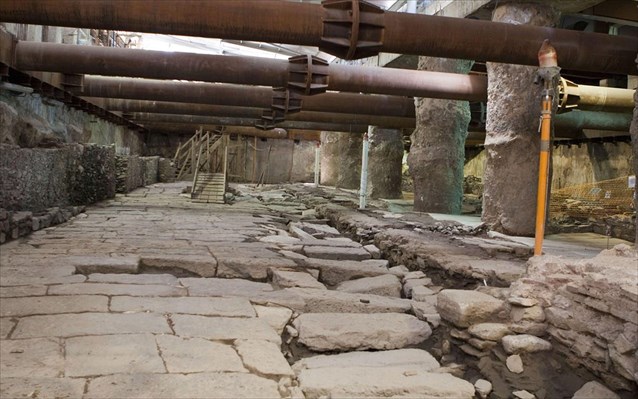Thessaloniki: regeneration as an ongoing process
Is the latest piece in the series of articles I have been doing for the "Europe in Baltimore" project of the EU National Institutes of Culture Washington Cluster on creative placemaking in Baltimore, linking the arts, creative industries, and transit in terms of Baltimore's three arts districts in Station North, Highlandtown and the newest in the Westside, called the Bromo Tower Arts and Entertainment District.
 Thessaloniki is Greece's second largest city, about 320 miles north of Athens, and is the unofficial capital of the Balkan nations in Southeastern Europe.
Thessaloniki is Greece's second largest city, about 320 miles north of Athens, and is the unofficial capital of the Balkan nations in Southeastern Europe.The White Tower of Thessaloniki dates to the 1400s and includes a display of city history. Flickr photo by Aris P.
This piece was tougher to write because there are fewer resources in English and I don't read Greek and at times it was a struggle to be "positive" because Greece's cities have been dealing with the fallout from the Global Recession, which has crushed Greece particularly hard, with a 30% drop in economic activity and a concomitant rise in unemployment, and because Greater Thessaloniki has political issues--a different fallout from the re-integration of former Soviet Block Balkan nations into Europe--and because their hosting of the Capital of Culture program was back in 1997.
At the same time, there are very exciting things happening in Thessaloniki, in part as a civic response to the economic crisis. And the city and region have a lot of assets in the natural, built, and maritime environments. Historic buildings and archaeological sites date back as much as 2000 years. (Excavations for the subway have turned up over 100,000 artifacts including part of the original Roman road, the Via Egnatia.)
Thessaloniki Otherwise is a fascinating civic involvement initiative spearheaded by Parallax, the local alternative magazine (comparable to DC's City Paper or the Chicago Reader or LA Weekly). Their big focus is on public space and planning.
Yiannis Boutaris, independent of the major political parties, progressive, and retired vintner is the Mayor, and he is working to rebuild and improve the city's operation and finances and has a great commitment to civic involvement. It looks like he will win re-election--the runoff election is next Sunday and he had the most votes in the primary, held last Sunday.
The city has been continuing to invest in public space improvements, especially in the waterfront. For example, it now holds a monthly "car free" event on the waterfront.
Separately, the EU is helping to fund the construction of a new subway system, which aims to help improve brutal traffic issues. The subway system is expected to open late in 2016.
There are a variety of knowledge industry development initiatives.
Railroad passenger services to Balkan nations were shut down in 2011 in response to the economic crisis, but were restored earlier this month to Macedonia, Serbia, and Bulgaria.
But it is still a struggle for the city government to build support for various economic development, tourism promotion, and government improvement initiatives. Cooperation at the Metropolitan scale is still difficult between the various municipalities.
I suggested that they use the opening of the subway system in 2016 as a milestone event around which to organize new more integrated initiatives to take the city to the next stage in its regeneration program, using planning and implementation models from Liverpool and Bilbao.
------
I learn a lot of new stuff with each piece I write and it has been a privilege to do the series.
Labels: cultural planning, culture and economic development, economic development planning, transportation planning, urban revitalization




4 Comments:
1. One thing that is missing from your piece is the importance of low-cost airfare as a tourism generator. Budapest reallly boomed that way. It can be a huge negative (drunk brits in Bulgarian ski resorts, ugly) but also brings young people in. If a city has enough charm (budapest) it can work.
2. Best practices!
3. I'd be very curious to know what exactly when wrong in planning in the post-war years. It wasn't as if cars weres not new (they had been around since the 20s) and it wasn't just a US thing (North Madrid comes to mind). They managed to build networks that are designed for maxixum congestion!
I personally am not as familiar as I should be with the impact of Ryanair, etc., in Europe.
I know about it has shaped significantly residential and visitatation flows within Europe, and you're right, I should have discussed it more, if only as a key element of intra-European integration, one that has nothing to do with EU directives, other than creating the framework for a common market, not unlike how the railroads and then the highway knitted together the US in very practical ways.
Yes, Europe had railroads and freeways, but the plane and really the low fares and the comparative speed at which a trip can be accomplished, has revolutionized mobility and migration within the EU.
Service from low cost carriers is a big issue with Thessaloniki of course. In the summer, they do have more flights than in off tourism months.
HOWEVER, the crash plus tension between Greece and Turkey make it difficult for Thessaloniki to develop say, direct flights between Istanbul.
Thessaloniki's opportunities for increased market share come from Turkey, Israel, and Russia, according to some of the academic papers I read. (That article I cited on city break tourism is very good generally in terms of the framework it lays out for assessing that segment of the tourism market more generally.)
I meant to write an extended passage about center vs. periphery issues both within Europe and within nations--in this case Greece. (It's an issue in Bilbao too, but mediated somewhat there because of the Basque nation within a nation.)
And eastern cities like Thessaloniki or Helsinki, and cities in the middle like Vienna have as much opportunity if not more in terms of being intersection points vis-a-vis eastern nations, businesses, people connection with Europe. For Marseille, it is north-south, with the Arab states, especially those that were former colonies.
With regard to intra-state elements, I developed that theme extensively in the piece about Liverpool, but I neglected to develop it to the same level in this piece.
It's the same issue. In countries where the "state" is so powerful, business activity (headquarters, companies get acquired, etc.) tends to flow toward the national capital. That hurt Liverpool, it hurts Thessaloniki.
I'd wager that there are some EU directives behind low cost airlines it clearly serves a lot of EU purposes.
And we are moving to that model where cities that have cheap airfares have a lot more potential for youth tourism. Baltimore in particular is very well suited. throw in the "car free weekend" and you've nailed it.
(I don't think car rentals are that expensive, but the hassle factor can be high in a new city.)
The City has a fascinating -- and tragic -- history. Prior to WWII and certainly prior to WWI it was a polyglot city with substantial populations of Bulgarians and Sephardic Jews. Indeed, as late as 1900, when the City was still part of the Ottoman Empire, Jews outnumbered both Greeks and Bulgarians and made up a plurality (1/3?) of the City's population. To this day some Bulgarians will argue that Bulgarians outnumbered Greeks at the time and that it really should be part of Bulgaria. The City is now almost entirely Greek; almost all of its Jewish population of 56,000 people were deported to concentration camps and killed over the course of a few weeks in 1943.
As for planning, I think that after WWII the City's population skyrocketed from a 200,000 or so people to well over a million with little consideration given to public transportation. Indeed, the postwar population boom probably coincided with the destruction and bustitution of the City's tramway system, which was extensive.
I was there a long time ago, in the 1980s, and I was young, so take my impression with a grain of salt. But, my impression was that the old town, including the part rebuilt after a fire in 1917, was incredibly beautiful but that everything that had grown up around it since WWII ranged from meh to downright ugly. The whole place was choked in some worst traffic I have ever seen and the air pollution was awful. It's good that they are building a subway -- they desperately needed one 30 years ago!
Anyway -- I enjoy these EU articles. Very interesting.
Post a Comment
<< Home